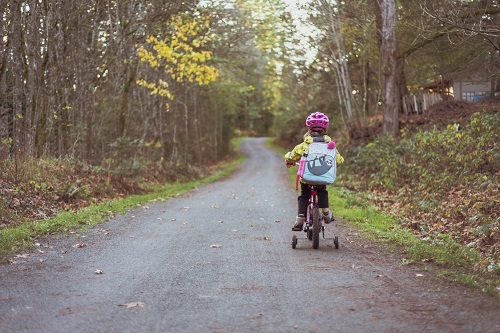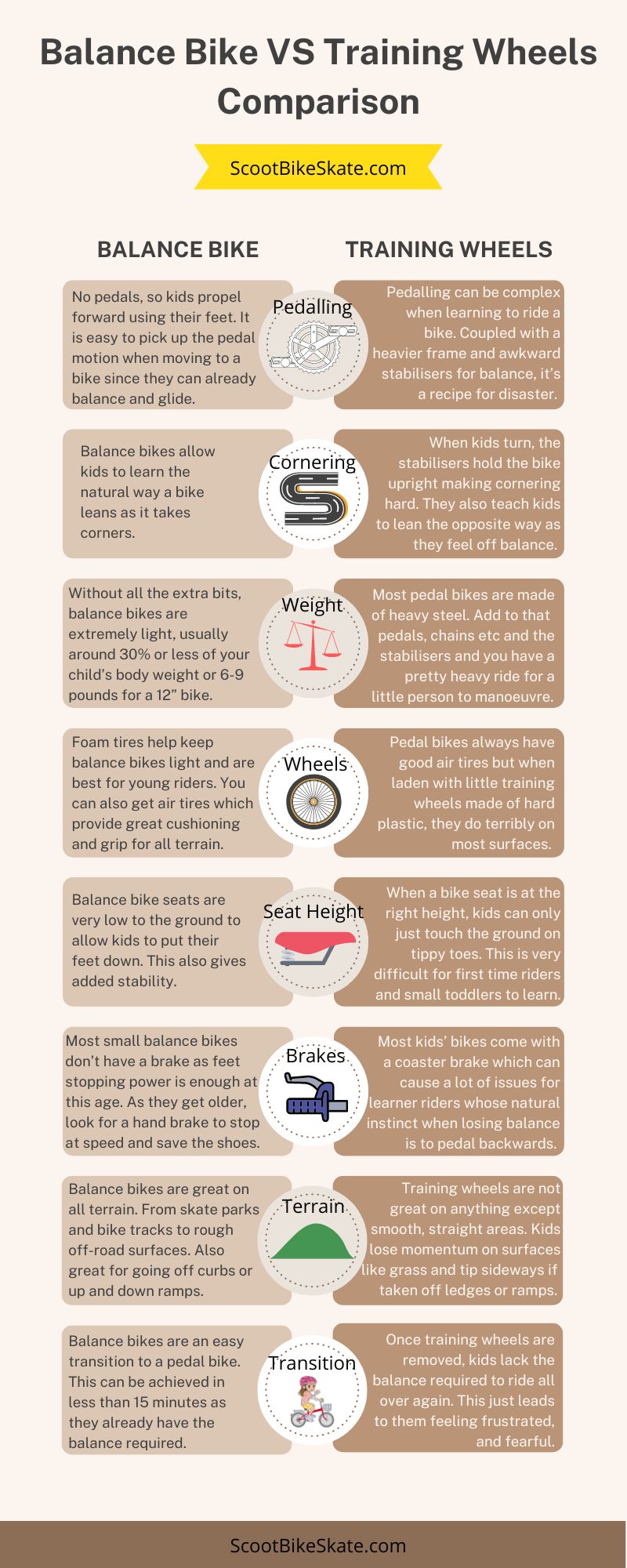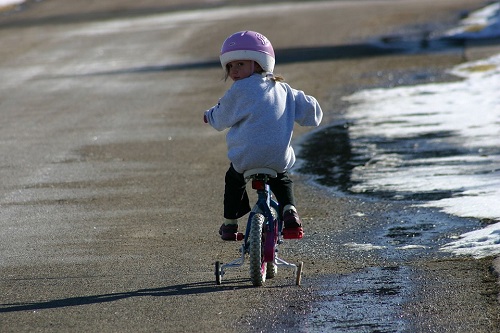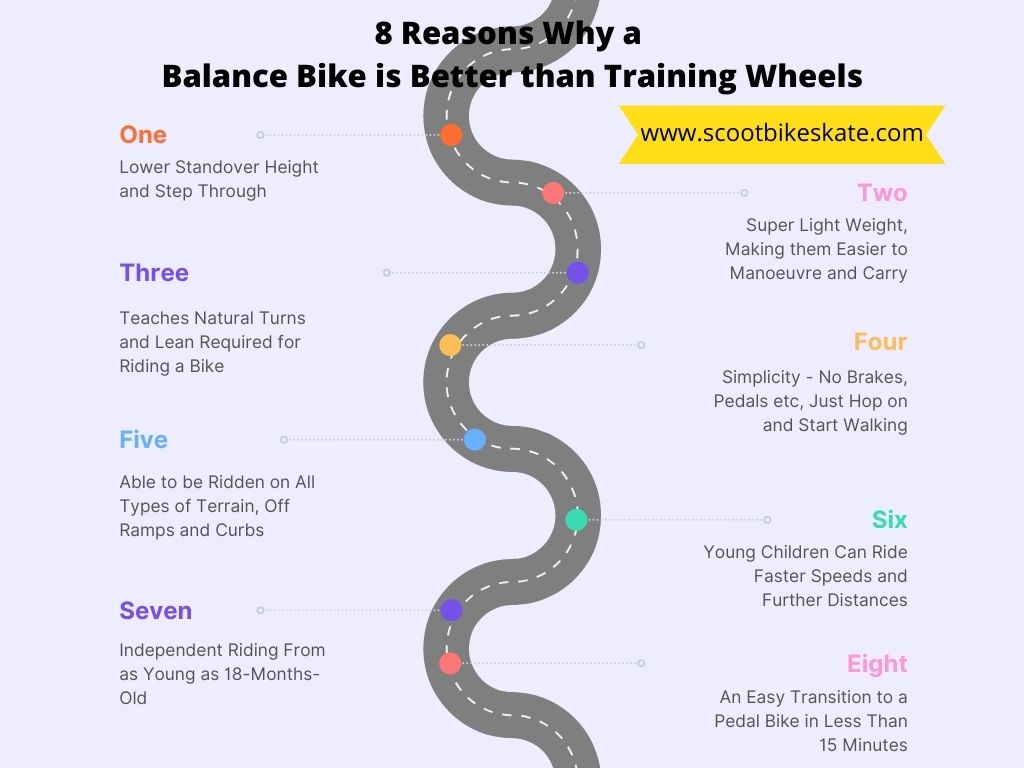Before the days of balance bikes, we probably all remember the tedious task of learning to ride a bike with training wheels or stabilisers as they are sometimes known. But just because that’s the way we did it, doesn’t mean it’s the best way.
If you grew up learning to ride with training wheels, you probably also remember the feeling of the awkward tilt they gave which actually made you want to lean the opposite way to what is natural for turning corners.

You probably recall tipping over at some point after trying to go down a slope. And you probably remember dad running as fast as he could behind you while you learnt to balance once the training wheels were removed.
So, which is better – balance bike or training wheels? I think our answer is fairly obvious that when it comes to balance bikes or stabilisers, we are heavily in the “team balance bike” camp. But keep reading so we can break down exactly why balance bikes are better than training wheels.
Table of Contents
- Difference Between Balance Bike and Training Wheels
- Infographic – Balance/ Strider Bike vs Training Wheels Comparison
- Are Balance Bikes Better Than Training Wheels?
- Why We Love a Balance Bike Vs Bike with Training Wheels
- 8 Reasons Why a Balance Bike Is Better Than Training Wheels
- Are There Any Benefits to a Bike with Training Wheels Vs Balance Bike?
- Balance Bike or Training Wheels For 3-Year-Olds And 4-Year-Olds?
- Balance Bike or Training Wheels FAQ’s

Difference Between Balance Bikes and Training Wheels
Essentially the difference between a balance bike and training wheels is that a balance bike is a pedal-less bike while the latter is a normal bike with two small added wheels on the rear wheel to provide extra stability.
With a balance bike, the rider uses their feet to propel forward and usually also to stop. With a bike that has training wheels, the rider rides the bike like a normal pedal bike and the added wheels on either side stop the bike from toppling over if they are riding too slow, have stopped or are just not adept at balancing on a bike yet.
You can read more about how balance bikes work in our full article coming soon.
Infographic Balance/ Strider Bike Vs Training Wheels Comparison

Are Balance Bikes Better Than Training Wheels?
In short, yes! Having the coordination to pedal at the same age as a child can pick up a balance bike (around 18 months to 2-years) is very unlikely. An 18-month who has just learnt to walk can often pick up a light weight balance bike, step through the low frame and walk along without much difficulty at all.
Before long, they will develop the confidence to sit and eventually stride along at speed. On the flip side a heavy bike, where their feet barely touch the ground is difficult enough to navigate let alone adding in the complexities of pedals and a brake because they can’t reach the floor to stop with their feet.
Why We Love a Balance Bike VS Bike with Training Wheels
Put simply, learning to pedal is actually the easiest part of learning to ride a bike. What isn’t easy is finding balance. This is why we recommend a balance bike vs bike with training wheels.
Starting with a strider bike allows kids to learn the all-important act of balancing while cruising along, all while being able to keep their feet planted firmly on the ground.
Once they have this down pat, learning to pedal is generally an easy transition. We cover more about this in our article on how to transition your child to a pedal bike.

8 Reasons Why a Balance Bike is Better Than Training Wheels
1. Lower Stand Over Height:
Balance bikes are generally lower to the ground in seat height than regular pedal bikes to allow the rider to push along with their feet. They usually also have a lower frame making stepping through the bike a lot easier for younger children. This overall lower centre of gravity makes for a more stable ride and is perfect for even the youngest of balance bike riders around 18-months to two-years-old.
To look at the numbers, small balance bikes have seat heights around 10” off the ground. The minimum seat heights of the smallest pedal bikes available in comparison are 17” off the ground. This means they aren’t appropriate until around 3-years-old versus 18-months-old for balance bike riders. Even then, when a bike seat is at the right height, kids can only just touch the ground on tippy toes. This is very difficult for first time riders and small toddlers to learn on.
2. Super Light Weight:
Regular bikes are often very heavy due to their frame material and all the added parts that you don’t find on a balance bike like pedals, chains, gears etc. We always say a balance bike should weight no more than 30% of your child’s weight and this is easily achieved with the excellent range of light weight balance bikes on the market. It’s common for a 12” balance bike to be between the 6–9-pound range, whereas a bicycle of the same wheel size is usually around the 12–15-pound mark.
Being light weight means a balance bike is able to be ridden much younger than a normal pedal bike. It’s also easier for any age to manoeuvre, push up hills and let’s face it for mum and dad to carry back to the car.
3. Teaches Natural Turns:
Its natural for a bike to lean when steering into corners. When children try to steer on a bike with training wheels, the bike is mostly kept in an upright position with leaning restricted by the training wheels.
While training wheels are designed to stop riders having falls, this can actually have the opposite effect when trying to turn with it tipping over if they turn too sharply. Training wheels also teach kids to actually lean the opposite way to what they should as they feel off balance.
Balance bikes on the other hand allow kids to turn as if on a normal bike without training wheels, encouraging them to learn the natural lean required for safe turning and corners. The lower centre of gravity we mentioned above also helps with making cornering easy-peasy.
4. Simplicity:
Nothing is simpler to learn when it comes to riding than a balance bike. We say if they can walk, they can use a balance bike and this is because a balance bike has no pedals so kids propel forward using their feet. It really is as simple as standing over the seat and walking along.
Once they have this down and can hold the bike and steer, they very quickly move to sitting and walking, then running and eventually gliding along with feet in the air.
When moving to a pedal bike it is usually a quick transition to pick up the natural pedal motion since they already have excellent balance and ability to glide.
Going for training wheels or stabilisers however adds in them having to learn to pedal, use a brake and sit on top of a seat to balance from the get go. A much more complex task.
Pedalling can be a bit complex when first learning to ride a bike. So, when you throw this at a young child on their first bike, coupled with a heavier frame and awkward stabilisers for balance, it’s a recipe for disaster.
Most small balance bikes don’t come with a brake as feet stopping power is enough at this age. As they get older, you can look for a hand brake to stop more easily at speed and save the shoes.
Most kids’ bikes come with a coaster brake which in addition to being another thing to learn, can cause a lot of issues for learner riders whose natural instinct when losing balance is to pedal backwards.
5. All Terrain:
A balance bike generally does well on all terrain types, especially if you have one with pneumatic air tires. Whether its smooth skate park cement, gravel, rocks, sand, dirt or grass, a balance bike is easily pushed through by the rider. Our toddler’s favourite balance bike trick is to lift his legs up as he cruises through big puddles or muddy pits. He also loves going off curbs and over ramps, which would be very awkward on a bike with training wheels.
Pedal bikes with 12” wheels tend to have shorter crank arms and are difficult to keep momentum through soft surfaces like grass or rough terrain like rocks. With training wheels made of hard plastic, they will often sink into the ground, making it hard to maintain momentum. They are also difficult to manoeuvre off things like curbs or even just over rocky ground. If you take it at the wrong angle the bike is likely to be tipped over by the training wheels. Overall, bikes with stabilisers are an unstable and awkward ride.
6. Speed and Distance:
Because balance bikes are so light (usually around half that of a pedal bike) and are easily propelled by the legs, toddlers can build up to much quicker speeds and sustain much longer distances when riding without tiring. This is great whether you are out riding trails as a family or you want to kill a few hours are the bike park. It’s also a lot more fun zooming around then plodding along on a bike with training wheels.
7. Independence from a Young Age:
Because toddlers can pick up and walk a balance bike from the time they can walk, they very quickly develop independence to be able to ride on their own. We find with tricycles and bikes with training wheels, kids require assistance to at least get initial momentum (and again every time they stop) and they are also limited to riding smooth, flat streets around home.
By the time they can even attempt a bike with stabilisers (around 3), they can be so confident on a balance bike that they can ride anywhere and for great distances. From skate parks with ramps and edges to bashing through bush trails, the places you will go on a balance bike are limitless.
8. An Easy Transition to a Pedal Bike:
You might be surprised to find that balance bikes are actually an easier transition to a pedal bike than starting with training wheels or stabilisers. In fact, most kids will move to a pedal bike at a much younger age if they have been using a balance bike vs a bike with training wheels.
Balance bikes give them the balance as we noted above and teach them what it feels like when they go too slow, turn too quick etc. Then its just a matter of jumping on a normal bike and getting the hang of the pedals which usually once they reach 3 or 4 years old is actually a very natural movement for them.
What we find you generally get with training wheels is a lack of balance when the training wheels are removed. And with that comes the frustration, fear and falls of learning the harder skill – balance.
Our experience with balance bikes on the other hand has seen kids who are ready transition from a balance bike to a pedal bike in less than 15 minutes. All they need to do is learn to pedal, which is actually quite a natural skill and off they go.
Our son was able to transition from his balance bike to a regular bike in just 2-3 short sessions in our laneway. He was confidently riding on his own months before his fourth birthday.

Are There Any Benefits to a Bike with Training Wheels VS Balance Bike?
In our opinion not really, but here are a few things to consider in favour of training wheels:They Fit to Nearly Any Bike
This means you can purchase the bike your child will use as a pedal bike later on, whack some training wheels on and off they go.
You will however have to buy the right size bike for their current height so you may end up having to upgrade to a bigger bike by the time they are ready to ditch training wheels anyway.
In which case we think you’re better off buying a small balance bike and then the next bike size up when they have outgrown the balance bike and are ready to give pedals a crack.
They’ve Taught Kids to Ride for Generations
Lets face it, you’ve never seen a high schooler using training wheels so all kids graduate from them eventually.
As your child becomes confident with pedalling, steering and using a brake to stop, it is possible to gradually wean them off stabilisers by repositioning the wheels so they are higher off the ground.
This forces them to start using small amounts of balance before they tilt far enough for the training wheel to catch them on one side.
Eventually they can be removed all together and they will get the hang of balancing on their own.
We find though it is a much quicker process to go from a balance bike straight to pedals without stabilisers.
Balance Bike or Training Wheels for 3-Year-Olds and 4-Year-Olds?
Around 3 to 4-years-old is when we are most commonly asked about whether parents should buy a balance bike or training wheels. This is likely because 3 is around the youngest age that a child can fit a regular bike. Before this they are way too big and heavy.
We still recommend a balance bike in this instance. With a balance bike, 3 to 4-year-olds can quickly develop balance and learn to be independent riders on any terrain and over long distances. And after a short time, they can transition to a regular bike without ever having the need for training wheels. This transition is much quicker and less frustrating than those trying to wean off training wheels.
<Coming soon – Best Balance Bikes for 3 and 4-Year-Olds>
Balance Bike Or Training Wheels FAQ’s
Can a 2-Year-Old Ride a Bike Without Training Wheels?
They sure can. Toddlers as young as 18-months can start to use a balance bike. Basically, if they can walk, they can use a balance bike. At 2-years-old they very quickly go from walking with their balance bike to sitting and eventually balancing for longer and longer distances as they build speed and confidence.
Read our Best Age for a Balance Bike article.
<Coming soon – Best Balance Bikes for 2-Year-Olds>
Is it Worth Getting a Balance Bike?
Absolutely. We are sometimes asked if a balance bike is a waste of money if you eventually end up buying a pedal bike anyway? But there are heaps of reasons we say it is worth the investment. For a start, toddlers can start on a balance bike when they are as young as 18-months-old, whereas most kids won’t fit a pedal bike comfortably until around 3-years-old.
Even if you don’t buy a balance bike until around 3, you can still buy models with great seat adjustability to last for a number of years and trust us when we say, your 3-year-old will have way more fun zooming around on a balance bike then plodding along on a bike with training wheels.
Lastly, once they master a balance bike, you can skip the training wheels altogether and go straight to a pedal bike in the next appropriate size.
Can You Put Training Wheels On a Balance Bike?
Balance bikes don’t need training wheels as there are no pedals. Instead, kids use their feet to propel forward or stop when they want. This means they develop natural balance when riding a bike. If they feel themselves toppling to the side, they will naturally put their foot down to stop, hence there is no need for training wheels on a balance bike.
Can I Take the Pedals Off a Bike to Make It a Balance Bike?
You can take the pedals (and cranks, chain etc) off a normal bike to turn it onto a balance bike of sorts but we don’t recommend this. Normal pedal bikes are generally taller than balance bikes so you will need to put the seat right down and even then, they may not be able to get their feet on the ground like they need to for a balance bike.
Pedal bikes are also usually made of steel which makes them heavier than balance bikes (usually close to 50% of your child’s weight instead of 25%).
Instead, we recommend that a cheap balance bike is a better idea or investing in a quality balance bike that can be passed onto younger siblings or sold for a good resale price on buy swap sell.
What Is the Average Age for a Child to Ride a Bike Without Stabilisers?
This really depends on when they start riding a bike and whether they use a balance bike or training wheels. If a child begins on a balance bike around age 2 then we’ve seen kids as young as 3 confidently riding pedal bikes without stabilisers.
If they use training wheels however then they won’t even begin riding until age 3, so it can be years after this before they are ready for a pedal bike without the need for stabilisers.
<coming soon – transition to a bike article>

